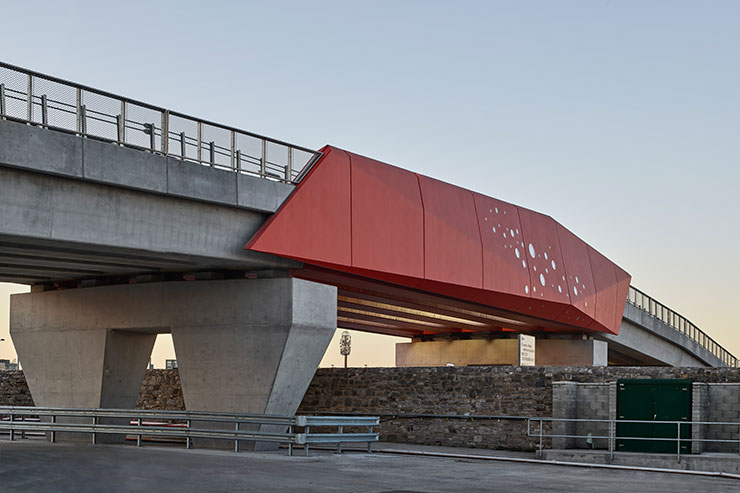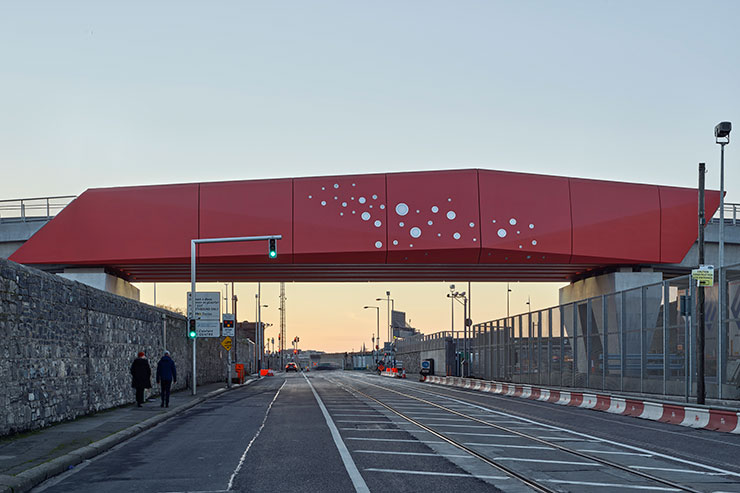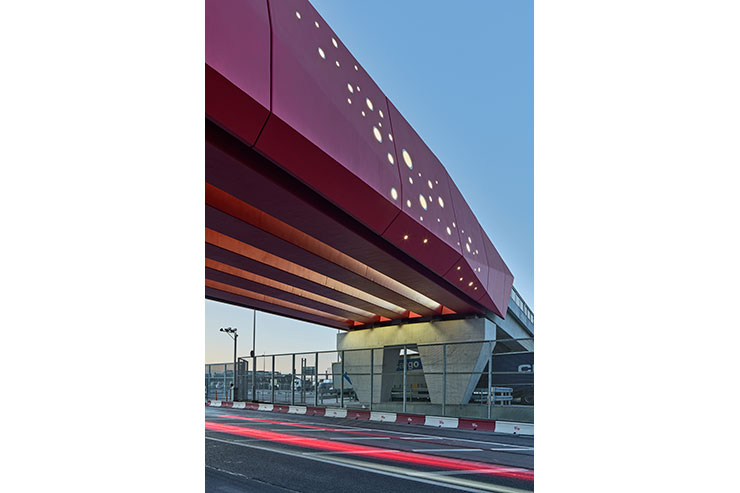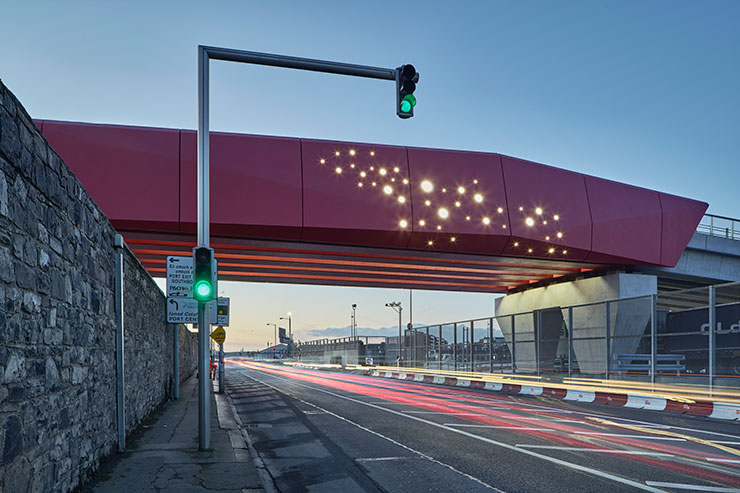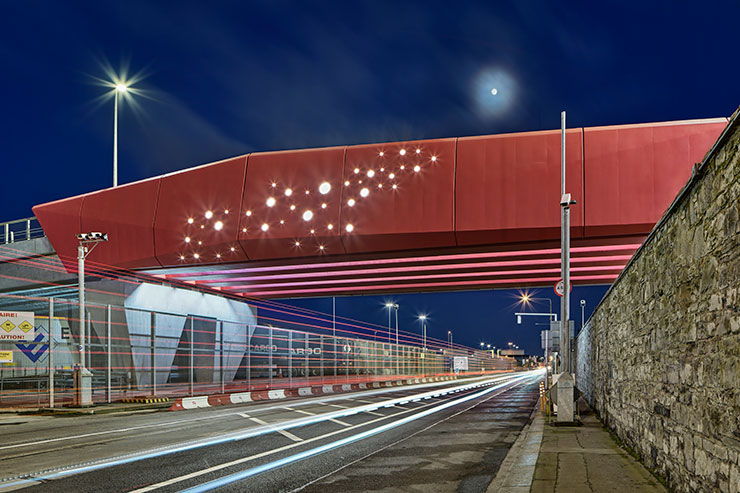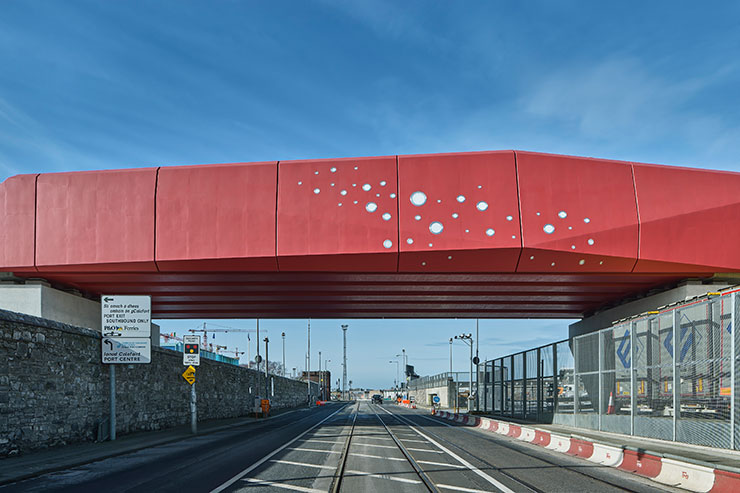This website uses cookies so that we can provide you with the best user experience possible. Cookie information is stored in your browser and performs functions such as recognising you when you return to our website and helping our team to understand which sections of the website you find most interesting and useful.
The Tidal Red Bridge, Ireland
ProjectThe Tidal Red BridgeLocationDublin, IrelandLighting DesignWink Lighting, IrelandArchitectDarmody Architects, IrelandAdditional DesignDBFL EngineersClientDublin PortLighting SuppliersLumenpulse, Linea Light, Martin Professional, MalhamPhotographyEnda Cavanagh
Terminal 4 Alexandra Road is a 150m long, 8m high, 13m wide two lane vehicular & footpath bridge over Alexandra road which connects terminal 4 to the CDL yard of Dublin Port. This forms part of a larger development plan for Dublin Port Centre development scheme(2012-2040) where the clients want to ‘Open the Port Centre to the Public’. Large scale Corten sculptural structures with perforated series of patterns redefine the boundaries and signal the port presence. The Poolbeg lighthouse, which robustly marks the entrance to Dublin Port, was the main inspiration for the look and feel of the bridge. Darmody architects wanted to carry its strength, simplicity and indeed colour to into the core design of the bridge.
There are four major light elements used to illuminate the bridge. The design of bridge itself has been clad in a distinct red glass fibre reinforced concrete panels which creates its distinct ‘strong and simple’ design.
There is a wave of precast holes of various diameters in the panel which house decorative light fittings which act as a focal point. The pattern is reminiscent of the Corten perforations seen elsewhere in the public realm thus drawing a connection between the commercial and public spaces. These dappled luminaires (88 in total) are connected to a tidal sensor, so when the tide is high, the lights sparkle brighter and inversely when the tide is low, the dim light levels. This brings a connection to the moon, to the sea and reminds us that the goods inwards and out ebbs and flows.
The red panels, crucially, were illuminated using 4 high power projectors with gobo shutters to perfectly frame the structure without light spill onto the upper deck and road below so as not to disturb pedestrians and road users.
The elegant ribbed underbelly of the bridge was illuminated using 8 high power projectors neatly installed in between each truss for minimal disruption of clean lines seen on the bridge. These have integrated honeycomb lenses to further reduce glare for passing users.
Finally, the road which links T4 to the CDL yard was illuminated using cleverly placed linear wall washers underneath the top rail of the crash barrier further promoting an integrated design. These 16 fittings wash the road uniformly and to the correct standards.
All fittings are dimmable to ensure efficiency, sustainability and flexibility of lighting levels. All fittings are RGBW except for the linear road washers illuminating the top deck.. This means that the bridge can be linked to other city buildings in case of special events further promoting a connection to the city which surrounds the port.
Typically, Dublin Port and the surrounding area is quite derelict at night and antisocial behaviour in the area is common. With the new regeneration plan of the port and this bridge, it creates a dynamic connection between the sea (tidal light controlled luminaires), the city’s heritage (the red Poolbeg lighthouse) and the people by connecting the terminals to the rail infrastructure. The innovative lighting and design of the bridge promotes a safer space to a once dark and dreary road.
The red bridge and the integral lighting celebrates the cultural identity of Dublin Port and the surrounding area. The lighting vibrantly illuminates the strong red colour of the bridge, which matches that of Poolbeg light house (a navigation mark entering into Dublin). The cascade of starlight across the bridge playfully link to the perforations of the Corten structures throughout the port itself. The lighting, controlled by the ebbs and flows of the tide connect us to the sea and the comings and goings of port and fishing life.
This space is a connection from the city to the Port which had been previously closed off by high walls and gates. The now accessible space, dynamically illuminated at night welcomes visitors and residents alike to share the space.
The light fittings are dimmable and twinkle to that of the ebbs and flow of the tide. This creates a dynamic nightscape to the surrounding urban environment. It also adds to the identity of Dublin Port. All necessary fittings have shutters / honeycomb louvres or have been positioned in a way where there is no unnecessary light spill or glare.
